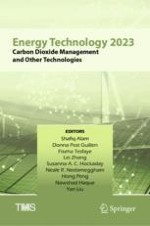Clean and sustainable energy is of paramount importance for industrial activities, economic development, environment, and public welfare. Aiming to reach NetZero, researchers in both academia and industry as well as policymakers are now putting tremendous efforts into the generation, storage, and applications of clean energy. This collection focuses on new and efficient energy technologies including innovative ore beneficiation, smelting technologies, recycling and waste heat recovery, and emerging novel energy solutions. The volume also covers a broad range of mature and new technological aspects of sustainable energy ecosystems, processes that improve energy efficiency, reduce thermal intensity and pollutants, and reduce carbon dioxide and other greenhouse emissions. Topics include, but are not limited to:• Energy efficient technologies for minerals, metals & materials processing
• Clean energy technologies, such as biomass, solar, wind, geothermal, nuclear including SMRs, hydrogen, etc.
• Renewable energy resources to reduce the consumption of traditional fossil fuels
• Emerging technologies for renewable energy harvesting, conversion, and storage
• New concepts or devices for energy generation, conversion, and distribution
• Waste heat recovery and other industrial energy efficient technologies
• Energy education and energy regulation
• Scale-up, stability, and life-cycle analysis of energy technologies and improvement of existing energy-intensive processes
• Theory and simulation in energy harvesting, conversion, and storage
• Design, operation, and optimization of processes for energy generation (e.g., carbon capture) and conversion of energy carriers
• Energy efficiency improvement in process engineering (e.g., for biomass conversion and improved combustion) and electrical engineering (e.g., for power conversion and developing smart grids)
• Thermo-electric/electrolysis/photo-electrolysis/fundamentals of PV
• Emission control, CO2 capture, and conversion
• Carbon sequestration techniques
• CO2 and other greenhouse gas reduction metallurgy in ferrous (iron & steel making and forming), non-ferrous and reactive metals including critical rare-earth metals
• Sustainability and life cycle assessment of energy systems
• Thermodynamics and modelling for sustainable metallurgical processes
• 'Smart cool materials' for urban heat island mitigation (such as cool roof infrared reflecting material, and low-temperature heat absorbers for use in air conditioner condensers - like 'endothermic materials')
• Methodologies for reducing the cost of energy materials production
• Circular economy and developing resource efficiency model for cutting down the transport from remote places
• Materials extraction and processing steps for enhancing energy efficiencies in batteries, supercapacitors, and energy efficient cells
• Foundational industry (metals-alloys, chemicals, refractories, cement) and energy economy and role of mineral extraction
